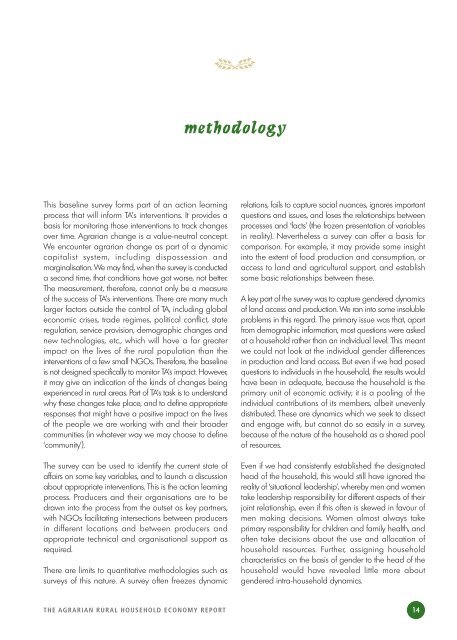THE AGRARIAN RURAL HOUSEHOLD ECONOMY
THE AGRARIAN RURAL HOUSEHOLD ECONOMY
THE AGRARIAN RURAL HOUSEHOLD ECONOMY
You also want an ePaper? Increase the reach of your titles
YUMPU automatically turns print PDFs into web optimized ePapers that Google loves.
This baseline survey forms part of an action learning<br />
process that will inform TA’s interventions. It provides a<br />
basis for monitoring those interventions to track changes<br />
over time. Agrarian change is a value-neutral concept.<br />
We encounter agrarian change as part of a dynamic<br />
capitalist system, including dispossession and<br />
marginalisation. We may find, when the survey is conducted<br />
a second time, that conditions have got worse, not better.<br />
The measurement, therefore, cannot only be a measure<br />
of the success of TA’s interventions. There are many much<br />
larger factors outside the control of TA, including global<br />
economic crises, trade regimes, political conflict, state<br />
regulation, service provision, demographic changes and<br />
new technologies, etc., which will have a far greater<br />
impact on the lives of the rural population than the<br />
interventions of a few small NGOs. Therefore, the baseline<br />
is not designed specifically to monitor TA’s impact. However,<br />
it may give an indication of the kinds of changes being<br />
experienced in rural areas. Part of TA’s task is to understand<br />
why these changes take place, and to define appropriate<br />
responses that might have a positive impact on the lives<br />
of the people we are working with and their broader<br />
communities (in whatever way we may choose to define<br />
‘community’).<br />
The survey can be used to identify the current state of<br />
affairs on some key variables, and to launch a discussion<br />
about appropriate interventions. This is the action learning<br />
process. Producers and their organisations are to be<br />
drawn into the process from the outset as key partners,<br />
with NGOs facilitating intersections between producers<br />
in different locations and between producers and<br />
appropriate technical and organisational support as<br />
required.<br />
There are limits to quantitative methodologies such as<br />
surveys of this nature. A survey often freezes dynamic<br />
<strong>THE</strong> <strong>AGRARIAN</strong> <strong>RURAL</strong> <strong>HOUSEHOLD</strong> <strong>ECONOMY</strong> REPORT<br />
methodology<br />
relations, fails to capture social nuances, ignores important<br />
questions and issues, and loses the relationships between<br />
processes and ‘facts’ (the frozen presentation of variables<br />
in reality). Nevertheless a survey can offer a basis for<br />
comparison. For example, it may provide some insight<br />
into the extent of food production and consumption, or<br />
access to land and agricultural support, and establish<br />
some basic relationships between these.<br />
A key part of the survey was to capture gendered dynamics<br />
of land access and production. We ran into some insoluble<br />
problems in this regard. The primary issue was that, apart<br />
from demographic information, most questions were asked<br />
at a household rather than an individual level. This meant<br />
we could not look at the individual gender differences<br />
in production and land access. But even if we had posed<br />
questions to individuals in the household, the results would<br />
have been in adequate, because the household is the<br />
primary unit of economic activity; it is a pooling of the<br />
individual contributions of its members, albeit unevenly<br />
distributed. These are dynamics which we seek to dissect<br />
and engage with, but cannot do so easily in a survey,<br />
because of the nature of the household as a shared pool<br />
of resources.<br />
Even if we had consistently established the designated<br />
head of the household, this would still have ignored the<br />
reality of ‘situational leadership’, whereby men and women<br />
take leadership responsibility for different aspects of their<br />
joint relationship, even if this often is skewed in favour of<br />
men making decisions. Women almost always take<br />
primary responsibility for children and family health, and<br />
often take decisions about the use and allocation of<br />
household resources. Further, assigning household<br />
characteristics on the basis of gender to the head of the<br />
household would have revealed little more about<br />
gendered intra-household dynamics.<br />
14


